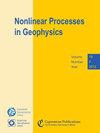加尔瓦尔喜马拉雅地区磁电uric数据中的地形效应建模
IF 2.4
4区 地球科学
Q3 GEOSCIENCES, MULTIDISCIPLINARY
引用次数: 0
摘要
摘要磁触电(MT)方法是一种被动地球物理技术,其基础是利用地电场和地磁场的时间变化来测量表层的电阻率。它是研究地壳深层结构最有效的地球物理技术之一,尤其是在像加瓦尔喜马拉雅地区这样的陡峭地形。由于地形起伏/崎岖,MT 的响应会发生扭曲。如果不对这些响应进行校正,就会误解 MT 数据与地质电结构之间的关系。在这项研究中,使用了两种不同的校正程序来计算从 Roorkee 到 Gangotri 段的 Garhwal 喜马拉雅地区合成模型的地形失真。使用有限差分算法计算不规则地形的 MT 响应(视电阻率和相位)。利用文献中不同时期不同地形模型的结果检验了地形校正程序的准确性。两种地形校正程序之间的相对误差是以平坦的地球表面为基准计算得出的,在罗尔基-甘格特里剖面沿线的大多数站点,误差几乎等于零,但山脚下除外,那里较短时间内的误差较大。两个地形校正响应(TCR1 和 TCR2)的相似地形程序表明,由于罗尔基-甘格特里剖面的坡角小于 1°,因此沿罗尔基-甘格特里剖面无需进行地形校正。本文章由计算机程序翻译,如有差异,请以英文原文为准。
Modelling of the terrain effect in magnetotelluric data from the Garhwal Himalaya region
Abstract. The magnetotelluric (MT) method is a passive geophysical technique based on using time variations in the geoelectric and geomagnetic field to measure the electrical resistivity of the surface layer. It is one of the most effective geophysical techniques to study the deep structure of the Earth's crust, particularly in steep terrain like the Garhwal Himalaya region. MT responses are distorted as a result of undulating/rugged terrain. Such responses, if not corrected, can lead to the misinterpretation of MT data with respect to geoelectrical structures. In this study, two different correction procedures were used to compute the topography distortion for a synthetic model of the Garhwal Himalaya region from the Roorkee to the Gangotri section. A finite-difference algorithm was used to compute the MT responses (apparent resistivity and phase) for irregular terrain. The accuracy of the terrain correction procedures was checked using the results of different topography models for various periods from the literature. The relative errors between two terrain correction procedures were calculated with respect to the flat earth surface and were almost equal to zero for most of the sites along the Roorkee–Gangotri profile except at the foothill, where the error was high for shorter periods. The similar topography procedures of two terrain-corrected responses (TCR1 and TCR2) showed that there is no need for topography correction along the Roorkee–Gangotri profile because the slope angle is less than 1°.
求助全文
通过发布文献求助,成功后即可免费获取论文全文。
去求助
来源期刊

Nonlinear Processes in Geophysics
地学-地球化学与地球物理
CiteScore
4.00
自引率
0.00%
发文量
21
审稿时长
6-12 weeks
期刊介绍:
Nonlinear Processes in Geophysics (NPG) is an international, inter-/trans-disciplinary, non-profit journal devoted to breaking the deadlocks often faced by standard approaches in Earth and space sciences. It therefore solicits disruptive and innovative concepts and methodologies, as well as original applications of these to address the ubiquitous complexity in geoscience systems, and in interacting social and biological systems. Such systems are nonlinear, with responses strongly non-proportional to perturbations, and show an associated extreme variability across scales.
 求助内容:
求助内容: 应助结果提醒方式:
应助结果提醒方式:


